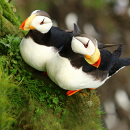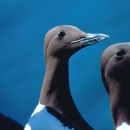Defining "Normal" with Long-Term, Time-series Data
Our seabird monitoring program provides long-term, time-series data. When the data reveal biologically-significant changes, scientists can test hypotheses about the causes of those changes. This long-term monitoring program is an integral part of the management of the Alaska Maritime Refuge. The information it provides is used to define "normal" variability in demographic parameters and identify patterns that fall outside norms, thereby signaling conservation issues.
Strategy for Data Collection
The strategy for colony monitoring includes estimating timing of nesting events, reproductive success, population trends, and prey used by representative species of various foraging guilds (e.g., murres are offshore diving fish-feeders, kittiwakes are offshore surface-feeding fish-feeders, auklets are diving plankton-feeders, etc.) at geographically dispersed breeding sites along the entire coastline of Alaska.
Monitoring Sites
A total of 10 sites on Alaska Maritime Refuge located roughly 300 to 500 km apart, are scheduled for annual surveys, and at least some data is available from all of these in most years. In addition, colonies near the annual sites are identified for less frequent surveys to "calibrate" the information gathered at the annual sites. Data provided from other research projects (e.g., those associated with evaluating the impacts of oil spills on marine birds) also supplement the monitoring database.
Annual Monitoring Field Sites
(from north to south around the coast)
- Cape Lisburne
- St. Paul Island
- St. George Island
- Buldir Island
- Kasatochi - No annual monitoring since the volcanic eruption of 2008.
- Aiktak
- Chowiet
- E. Amatuli in the Barren Islands
- St. Lazaria
Examples of Target Species for Seabird Monitoring
| Feeding Method | Diet | Feed Nearshore | Feed Offshore |
|---|---|---|---|
| Surface | Fish-eating Plankton-eating | Gull Fork-tailed storm-petrel | Kittiwake Leach's storm-petrel |
| Diving | Fish-eating Plankton-eating | Guillemots Whiskered auklets | Murres Least auklets |











